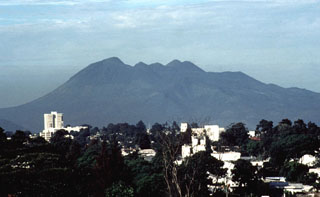Report on Pacaya (Guatemala) — March 1986
Scientific Event Alert Network Bulletin, vol. 11, no. 3 (March 1986)
Managing Editor: Lindsay McClelland.
Pacaya (Guatemala) Explosive activity builds new cones; lava flows
Please cite this report as:
Global Volcanism Program, 1986. Report on Pacaya (Guatemala) (McClelland, L., ed.). Scientific Event Alert Network Bulletin, 11:3. Smithsonian Institution. https://doi.org/10.5479/si.GVP.SEAN198603-342110
Pacaya
Guatemala
14.382°N, 90.601°W; summit elev. 2569 m
All times are local (unless otherwise noted)
Pacaya has been almost continuously active since 1965. Strombolian activity, sometimes accompanied by lava flows, began in February 1981 and increased in March 1983 [from 11:12]. By the end of 1983 a large cone had been built in MacKenney Crater. Lava emerged from various vents between there, an older cone to the north (Cerro Chino), and the nearby somma wall through early 1985.
Alfredo MacKenney reported that between 5 May and 28 July, 1985, the two cones that had formed earlier that year (one within MacKenney Crater and the other on the E wall) had increased substantially in size because of the continuous moderate explosive activity. On two occasions (30 June and 28 July) lava flows emerged toward the N and SW. On 11 August, another crater had formed between the two earlier cones, which maintained strong explosive activity until 13 October. From 19 October until 10 December, renewed activity occurred from the E cone, building a perfectly-shaped cone that reached the height of Pacaya Crater (2,500 m). Between 9 December 1985 and 16 February 1986, a large upper crater formed in this cone, which maintained strong constant pyroclastic explosions visible from Guatemala City (~ 25 km NNE). On 19 January a small lava dome had formed at the W base of MacKenney Crater, and from there lava flows extended N, S, and W. On 2 February, a large lava flow was moving W and on 2 March another was advancing S. As of 9 March, explosive activity continued to eject scoria and gases from the upper crater of the new cone, and lava flowed from its NW base.
Geological Summary. Eruptions from Pacaya are frequently visible from Guatemala City, the nation's capital. This complex basaltic volcano was constructed just outside the southern topographic rim of the 14 x 16 km Pleistocene Amatitlán caldera. A cluster of dacitic lava domes occupies the southern caldera floor. The post-caldera Pacaya massif includes the older Pacaya Viejo and Cerro Grande stratovolcanoes and the currently active Mackenney stratovolcano. Collapse of Pacaya Viejo between 600 and 1,500 years ago produced a debris-avalanche deposit that extends 25 km onto the Pacific coastal plain and left an arcuate scarp inside which the modern Pacaya volcano (Mackenney cone) grew. The NW-flank Cerro Chino crater was last active in the 19th century. During the past several decades, activity has consisted of frequent Strombolian eruptions with intermittent lava flow extrusion that has partially filled in the caldera moat and covered the flanks of Mackenney cone, punctuated by occasional larger explosive eruptions that partially destroy the summit.
Information Contacts: A. MacKenney, Guatemala City.

